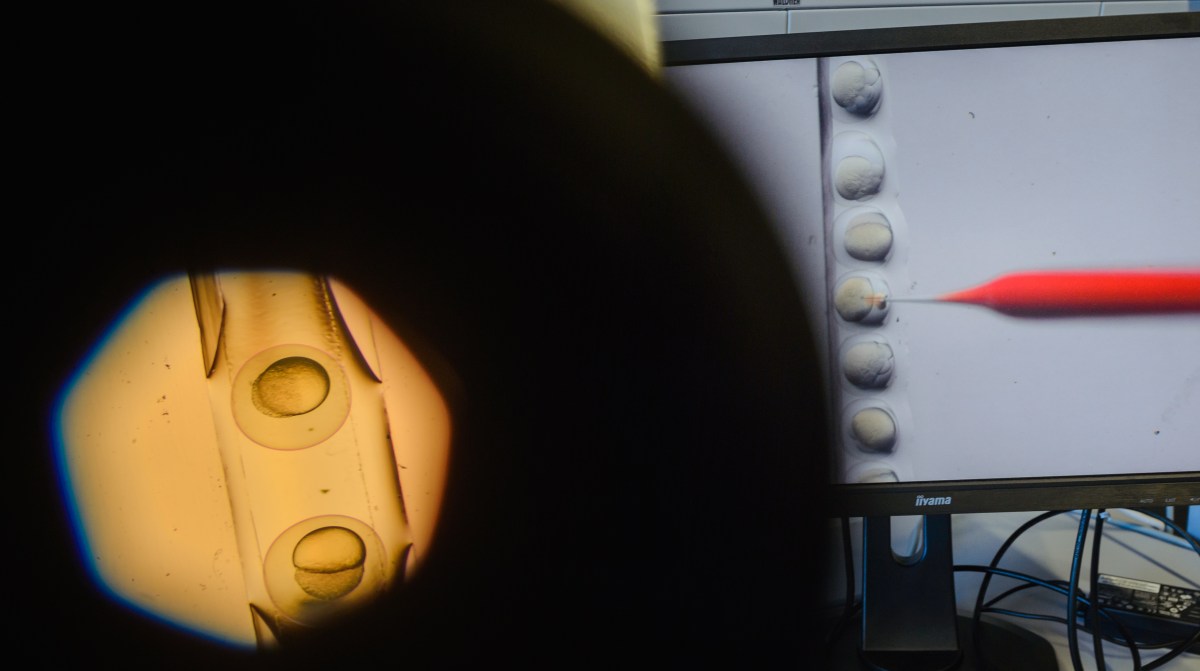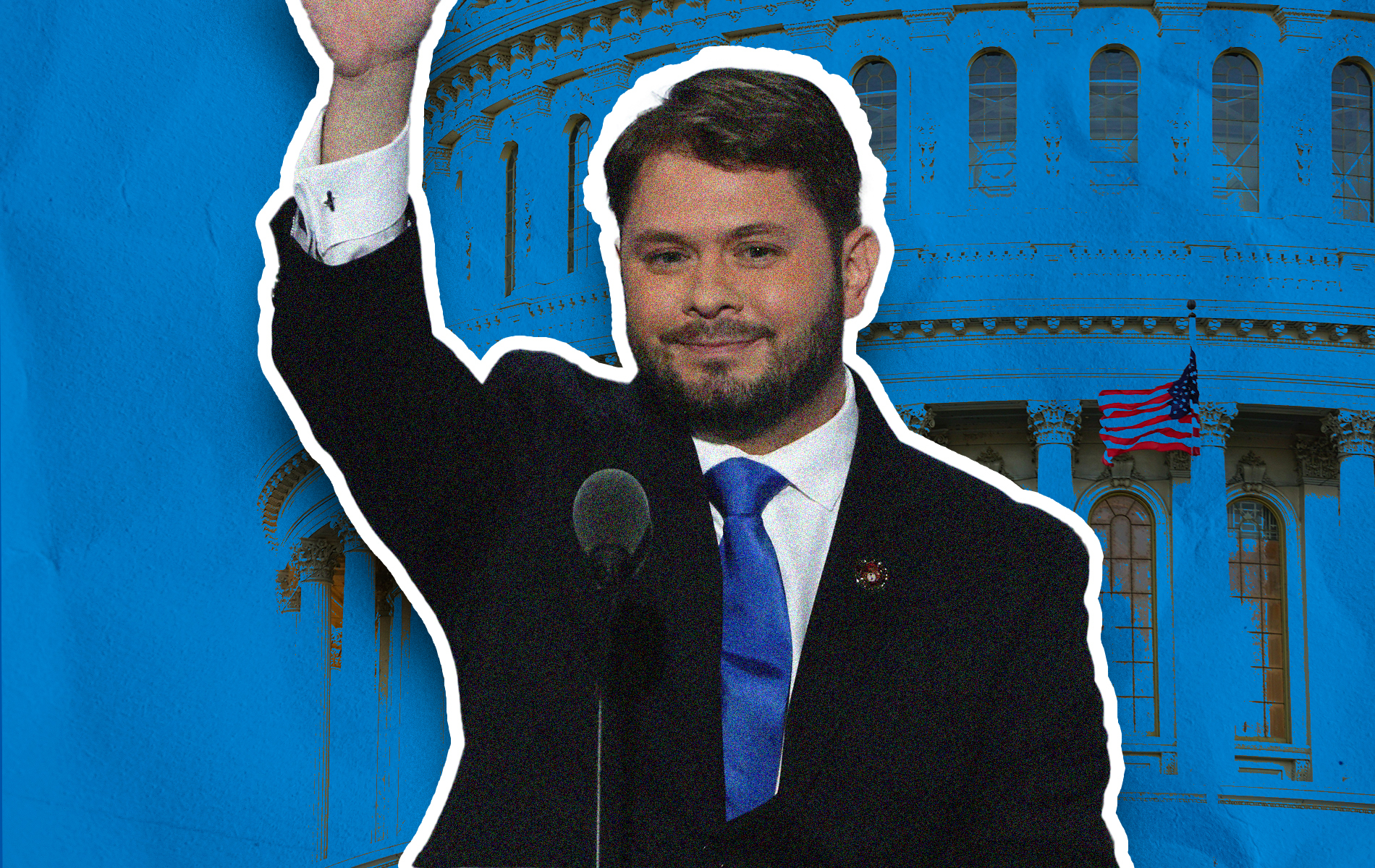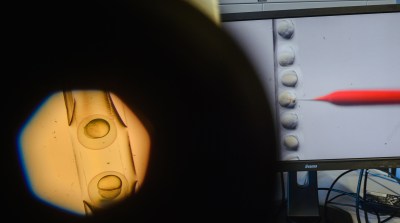Happy Thursday! The British government is considering classifying the wildly dangerous sport of Gloucestershire cheese rolling as part of the country’s “intangible cultural heritage.” Commentator Stephen A. Smith called the venerable sport “absolutely asinine” this week. We’ll let you judge for yourselves.
Quick Hits: Today’s Top Stories
- A panel of judges from the U.S. Court of International Trade on Wednesday blocked multiple tariffs imposed by President Donald Trump on China and other trade partners, finding that the tariffs went beyond the scope of the law he invoked to enact them. In a lawsuit brought by the Liberty Justice Center, the judges ruled that the 1977 International Emergency Economic Powers Act, under which Trump justified tariffs on dozens of countries, did not grant the president “unbounded authority” to impose tariffs. Other tariffs imposed under different authorities, such as those on automobiles and metals, remain in place.
- Ukrainian President Volodymyr Zelensky met with German Chancellor Friedrich Merz in Berlin on Wednesday, and Merz committed to increasing German support for Ukraine.* Speaking at a joint press conference, Merz said his country would provide more military equipment and funding for domestic Ukrainian weapons production. The German Defense Ministry later clarified that the support would be valued at roughly $5.7 billion and include financing for satellites and the production of long-range weapons systems.
- Tesla and SpaceX CEO Elon Musk, who recently stepped back from the Department of Government Efficiency (DOGE), on Tuesday criticized the pending legislation that Trump calls his “big beautiful bill.” In an interview with CBS News, Musk said the bill “undermines the work” of DOGE due to its expansion of the federal budget deficit. The statements were his first major criticisms of the Trump administration and came after his decision to refocus on work at his companies following declines in Tesla stock prices and increasing public controversy.
- Four Palestinians died Wednesday as crowds stormed a United Nations food warehouse in Gaza, according to officials at Al-Aqsa Martyrs Hospital. The riot came a day after one person died and dozens were injured at another aid distribution site in the Gaza Strip. According to news reports, 48 people at this first riot suffered gunshot wounds, though it is unclear who did the shooting; the Israeli military reported firing only warning shots, and military contractors at the scene denied opening fire.
- Vladimir Medinsky, who is heading Russia’s negotiations with Ukraine, proposed Wednesday that Russian and Ukrainian officials meet on June 2 in Istanbul for another round of peace talks. Medinsky suggested the two sides exchange their ideas for a peace treaty, while Ukrainian officials are reportedly considering whether to accept the offer. Reuters reported Wednesday that Russian President Vladimir Putin’s conditions for a peace deal include a written commitment by NATO not to expand eastward, as well as Ukrainian neutrality and the lifting of some Western sanctions.
- Following his criticism earlier this week of Putin for not seriously engaging with the peace process, Trump on Wednesday indicated that he would not impose further sanctions on Russia if he thought a peace deal was likely. “We’re going to find out whether or not he’s tapping us along or not, and if he is, we’ll respond a little bit differently,” the president said. On Tuesday, Trump said that Putin was “playing with fire” by refusing to show that he was committed to serious peace talks with Ukraine.
- Trump on Wednesday nominated Emil Bove, a Justice Department official and one of his former personal attorneys, to the U.S. Court of Appeals for the 3rd Circuit. In February, Bove spearheaded the Justice Department’s efforts to drop the federal corruption case against New York City Mayor Eric Adams, which prompted a wave of high-profile resignations from the DOJ. That same month, Bove also ordered that the FBI turn over the names of thousands of employees who worked on investigations related to the January 6, 2021, riots at the U.S. Capitol. “He will end the Weaponization of Justice, restore the Rule of Law, and do anything else that is necessary to, MAKE AMERICA GREAT AGAIN,” wrote Trump in a social media post announcing the nomination.
Gene Editing Breakthroughs Begin to Bear Fruit

Kyle and Nicole Muldoon faced a parent’s nightmare after their son KJ was born last year. When he was just days old, doctors diagnosed KJ with an incredibly rare genetic disorder known as severe carbamoyl-phosphate synthetase 1 (CPS1) deficiency—a condition where ammonia produced from breaking down proteins builds up in the body at toxic levels. Babies like KJ lack the necessary enzyme to convert ammonia to urea that is then excreted in urine.
Only about one in 1.3 million babies have the deficiency, and the traditional treatment is a liver transplant. The deficiency can result in lifelong neurological harm or even death as babies wait to be big enough to handle a transplant. About half of infants with CPS1 deficiency don’t survive their first week of life.
But instead KJ became the first patient ever to receive a CRISPR gene-editing treatment customized specifically for him. It was done so by a team of doctors and researchers at Children’s Hospital of Philadelphia, the Perelman School of Medicine at the University of Pennsylvania, the University of California, Berkeley, and several other institutions. After 10 months and three courses of the treatment, KJ is doing well and able to handle more protein in his diet. “We’ve been in the thick of this since KJ was born, and our whole world’s been revolving around this little guy and his stay in the hospital,” Kyle Muldoon said earlier this month. “We’re so excited to be able to finally be together at home so that KJ can be with his siblings, and we can finally take a deep breath.”
Doctors and researchers who worked on KJ’s case are hopeful the breakthrough can lead to more tailored gene therapies for rare genetic disorders that have seen far less drug development than more common diseases.
“Years and years of progress in gene editing and collaboration between researchers and clinicians made this moment possible, and while KJ is just one patient, we hope he is the first of many to benefit from a methodology that can be scaled to fit an individual patient’s needs,” said Rebecca Ahrens-Nicklas, the director of the Gene Therapy for Inherited Metabolic Disorders Frontier Program (GTIMD) at Children’s Hospital of Philadelphia and the doctor leading KJ’s care.
CRISPR, which stands for clustered regularly interspaced short palindromic repeats, is an immune system within small organisms like bacteria that enables them to identify and destroy the DNA of attacking viruses. Using technology called CRISPR-Cas9, scientists are able to engineer that system to find, cut, and edit specific sequences of the human genome that are responsible for disease. “Precise, corrective CRISPR-Cas9 Technology … can potentially address more than 90% of pathogenic variants in genetic diseases that, although rare individually, collectively affect hundreds of millions of people worldwide,” Ahrens-Nicklas and her colleagues working on the treatment wrote in a report on KJ’s case published in the New England Journal of Medicine earlier this month.
Gene editing treatments have been around since the 1990s, but in 2012, the Nobel Prize-winning discovery of CRISPR’s usefulness in gene editing supercharged research and development in the field. In the years since, researchers have hailed CRISPR gene editing as the future of medicine, and in recent years, the promise of the technology has begun to translate into actual treatments.
“It’s a reality now,” Erik Sontheimer, a gene editor and professor at the University of Massachusetts Chan Medical School, told TMD. “There are CRISPR people walking among us who have really had their lives transformed by CRISPR therapies.”
KJ is the latest of several gene therapy breakthroughs in recent years. In 2018, 7-year-old Mila Makovec, suffering from the fatal neurological disorder called Batten disease, became the first patient to ever receive a drug treatment developed for a single individual. Dr. Timothy Yu of the Boston Children’s Hospital’s division of genetic and genomics quickly identified the specific gene mutation causing Mila’s illness and developed a customized drug that would bind to the mutated gene and effectively patch it in what Yu described as “a molecular Band-aid, allowing the gene to assemble properly.”
Ultimately, the disease had progressed too far, and Mila died at the age of 10. But her custom drug, named milasen, helped reinvigorate research interest in finding treatments to help people with rare genetic conditions that often receive little to no development investment from pharmaceutical companies.
Mila’s case involved an individualized drug, not a CRISPR gene edit, but her treatment and KJ’s have the potential to help people with rare—often called “n of 1”—diseases. Mila’s mother Julia Vitarello has since become a leading advocate for individualized medicine to treat rare conditions, founding the N=1 Collaborative. “Just as technology is revealing thousands of genetic conditions behind previously unexplained symptoms, Mila and KJ’s stories are proving an entirely new way of treating those who suffer from genetic disease,” she wrote in an op-ed last week.
Another gene therapy breakthrough came in December 2023, when the Food and Drug Administration (FDA) approved the first gene-editing treatment for sickle cell disease. The hereditary blood condition affects more than 100,000 people in the U.S. and millions more globally. The treatment known as Casgevy works by using CRISPR to disrupt or “knock out” the gene that stems the development of fetal blood cells, Sontheimer told TMD. “If you can shut down the mechanism that prevents fetal hemoglobin from being expressed in adults, then fetal hemoglobin comes back on and takes over and covers for the defect in adult hemoglobin,” he said.
It’s not surprising that drug companies like Vertex Pharmaceuticals, one of the developers of Casgevy, are willing to put up the hundreds of millions of dollars necessary to scale a new gene therapy when the treatment is applicable to a large patient population. The challenge is securing resources to develop treatments for the array of rarer disorders that taken separately only affect small groups but cumulatively affect millions.
KJ’s gene therapy is specific to him and, unlike Casgevy, it can’t be directly used for other patients. But gene editors believe that, in theory, the treatment could be tweaked and used for other patients with the same disorder and even patients with other genetic disorders. “It lays out a pathway to do this for other patients who have other mutations that could, in principle, be treated in the same fashion,” Sontheimer said. “KJ’s treatment had a specific guide RNA, that was tailored specifically to him and specifically to one of his mutations. The base editor machinery … could very well be applied in other cases just with a different guide RNA that sends it to a different mutation.”
“This is a little bit like a letter in an envelope where for other conditions now, not for every other one but for some, all that’s going to be required here is changing the address as opposed to re-writing the letter,” said Peter Marks, who oversaw gene therapy approvals at the FDA until he resigned earlier this year over disagreements with Health and Human Services Secretary Robert F. Kennedy Jr.
Fydor Urnov, one of the researchers who worked on KJ’s treatment, emphasized the significance of KJ’s case as a route to more therapies for rare conditions. “You can go from CRISPR for baby KJ to CRISPR for baby number two by changing a tiny bit of the overall medicine,” he said. Such an approach could significantly cut down the cost of developing gene editing therapies for patients and other disorders. Treatment development could become more commercially viable since it would involve a larger patient population—and each “n of 1” therapy wouldn’t require actually starting from square one.
Urnov also said costs could reduce if the safety studies from already approved treatments could be applied to shared elements of new gene editing, removing the need to re-do expensive processes. “If we’re using a whole bunch of previous components we’ve already de-risked using extensive studies, we don’t need to do that again,” he said.
Gene editors and specialists have an expansive vision for treating more children more quickly with CRISPR gene therapies. “Working with the FDA, our community is actively moving towards a future where we bring together newborns like [KJ] into this sort of beautiful little ward where we say to the FDA, and we say to the doctors, ‘Does this child have a devastating newborn disorder of metabolism, where the liver there’s a typo in a gene, the liver doesn’t work, the child is suffering? You can go into the special ward, and anyone with that type of disease can get a CRISPR built exactly the way that we built it for KJ,’” Urnov said.
Urnov recognized that a lot of work and policy changes are necessary to develop such a treatment model. But he insisted now is the time to get started. “Starting now, as of baby KJ, we are out of excuses in terms of not providing this to other children like him,” he said.
Today’s Must-Read
Freshman Arizona Sen. Ruben Gallego was a rare bright spot for Democrats in an otherwise bleak 2024. In a year when Donald Trump won all seven battleground states and Democrats lost three Senate seats, Gallego defeated Republican Kari Lake in Arizona by 2.4 points—despite Trump carrying the state by 5.5 points in the presidential race. It’s little wonder, then, that Gallego’s name is routinely tossed around as a plausible 2028 presidential candidate. Just a few weeks after he took office, Gallego landed at No. 6 in a Washington Post article titled “The 12 Democrats who make the most sense for 2028.”
Toeing the Company Line
Same as It Never Was
The right yearns for—and the left wants to escape from—a culture that didn’t exist.
‘No MAGA Left Behind’
Everything is a trial balloon.
The Quiet Realignment
How allies are adapting to American uncertainty.
Dead Man Walking Precedent
Did SCOTUS overrule Humphrey’s Executor?
Worth Your Time
- In The Atlantic, Rose Horowitch reported on the emergence of an unlikely alliance at Johns Hopkins University: a partnership between conservatives and academia. “Johns Hopkins recently unveiled a partnership with the American Enterprise Institute (AEI), a center-right think tank, designed to inject some ideological diversity into the university. Steven Teles, a political scientist who wrote a widely discussed article last year for The Chronicle of Higher Education titled ‘Why Are There So Few Conservative Professors?,’ is one of the faculty members involved with the partnership. The institutions will collaborate on a number of efforts to integrate conservative and heterodox thinkers…Johns Hopkins is part of a growing trend. Several elite red-state public universities have recently established academic centers designed to attract conservative scholars. And institutions that haven’t sought out conservative faculty may soon find new reasons to do so. The Trump administration has demanded that Harvard hire additional conservative professors or risk losing even more of its federal funding. (Even as it made that demand, it insisted that Harvard adopt ‘merit-based admissions policies and cease all preferences based on race, color, national origin, or proxies thereof.’) In response, Harvard’s president said that the university is expanding programs to increase intellectual diversity on campus. The era of DEI for conservatives has begun.”
- A piece in the Economist examines how America, long a magnet for academic talent from around the world, risks losing scientists and researchers to other countries: “Why is America losing its allure? The most straightforward reason is money, or the looming lack of it. Mr Trump’s administration has cancelled thousands of research grants since January, when he took office. Grant Watch, a website, calculates that at least $2.5bn-worth have been rescinded so far, leaving researchers without salaries and unable to pay expenses. Much more could be coming. … Funding is not the only issue. Many scientists, especially those who are citizens of other countries, are beginning to feel intimidated. In the first four months of 2025 at least 1,800 international students or recent grads had their visas revoked without explanation, only to have them restored again in April. Senior scientists report difficulty obtaining visas for incoming researchers, and have advised junior colleagues from overseas not to travel home, lest they be detained on their return.”
Presented Without Comment
Politico: RFK Jr. threatens to bar government scientists from publishing in leading medical journals
Also Presented Without Comment
CBS News: Trump’s pardon attorney discussed pardoning final Jan. 6 defendants—including Oath Keepers’ Stewart Rhodes, lawyer says
In the Zeitgeist
With a series-clinching win over the Minnesota Timberwolves, the Oklahoma City Thunder have become the youngest-ever team to reach the NBA finals, with an average age of 25. That’s…. younger than two-thirds of the TMD team. Here’s a highlight reel of their (gulp) 26-year-old MVP point guard, Shai Gilgeous-Alexander.
Let Us Know
Are you excited about the prospect of more gene-editing therapies? Do you personally know anyone who could be helped by such technology?
Correction, June 8, 2025: This newsletter has been updated to correct Volodymyr Zelensky’s title.












Please note that we at The Dispatch hold ourselves, our work, and our commenters to a higher standard than other places on the internet. We welcome comments that foster genuine debate or discussion—including comments critical of us or our work—but responses that include ad hominem attacks on fellow Dispatch members or are intended to stoke fear and anger may be moderated.
With your membership, you only have the ability to comment on The Morning Dispatch articles. Consider upgrading to join the conversation everywhere.